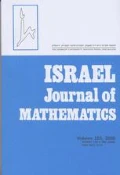Abstract
Relative entropy tuples both in topological and measure-theoretical settings, relative uniformly positive entropy (rel.-u.p.e.) and relative completely positive entropy (rel.-c.p.e.) are studied. It is shown that a relative topological Pinsker factor can be deduced by the smallest closed invariant equivalence relation containing the set of relative entropy pairs. A relative disjointness theorem involving relative topological entropy is proved. Moreover, it is shown that the product of finite rel.-c.p.e. extensions is also rel.-c.p.e..
Similar content being viewed by others
References
F. Blanchard, Fully positive topological entropy and topological mixing, in Symbolic Dynamics and its Applications, Contemporary Mathematics 135 (1992), 95–105.
F. Blanchard, A disjointness theorem involving topological entropy, Bulletin de la Société Mathématique de France 121 (1993), 465–478.
F. Blanchard, E. Glasner and B. Host, A variation on the variational principle and applications to entropy pairs, Ergodic Theory and Dynamical Systems 17 (1997), 29–43.
F. Blanchard, B. Host and S. Ruette, Asymptotic pairs in positive-entropy systems, Ergodic Theory and Dynamical Systems 22 (2002), 671–686.
F. Blanchard and Y. Lacroix, Zero-entropy factors of topological flows, Proceedings of the American Mathematical Society 119 (1993), 985–992.
F. Blanchard, B. Host, A. Maass, S. Martínez and D. Rudolph, Entropy pairs for a measure, Ergodic Theory and Dynamical Systems 15 (1995), 621–632.
M. Denker, C. Grillenberger and K. Sigmund, Ergodic Theory on Compact Spacesw, Lecture Notes in Mathematics 527, Springer-Verlag, New York, 1976.
T. Downarowicz and J. Serafin, Fiber entropy and conditional variational principles in compact non-metrizable spaces, Fundamenta Mathematicae 172 (2002), 217–247.
D. Dou, X. Ye and G. H. Zhang, Entropy sequences and maximal entropy sets, Nonlinearity 19 (2006), 53–74.
H. Furstenberg, Disjointness in ergodic theory, minimal sets, and a problem in diophantine approximation, Mathematical Systems Theory 1 (1967), 1–49.
E. Glasner, A simple characterization of the set of μ-entropy pairs and applications, Israel Journal of Mathematics 102 (1997), 13–27.
E. Glasner, Ergodic Theory via Joinings, Mathematical Surveys and Monographs 101, American Mathematical Society, Providence, RI, 2003.
E. Glasner and B. Weiss, Sensitive dependence on initial conditions, Nonlinearity 6 (1993), 1067–1075.
E. Glasner and B. Weiss, Topological entropy of extensions, in Ergodic Theory and its Connections with Harmonic Analysis, Cambridge University Press, 1995, pp. 299–307.
E. Glasner and B. Weiss, Locally equicontinuous dynamical systems, Colloquium Mathematicum 84–85 (2000), 345–361.
E. Glasner and B. Weiss, On the interplay between measurable and topological dynamics, in Handbook of Dynamical Systems, Vol. 1B (Hasselblatt and Katok, eds.), Elsevier, 2006, pp. 597–648.
W. Huang, S. Shao and X. Ye, Mixing via sequence entropy, in Algebraic and topological dynamis, Contemporary Mathematics 358, American Mathematical Society, Providence, RI, 2005, pp. 101–122.
W. Huang and X. Ye, Topological complexity, return times and weak disjointness, Ergodic Theory and Dynamical Systems 24 (2004), 825–846.
W. Huang and X. Ye, A local variational relation and applications, Israel Journal of Mathematics 151 (2006), 237–279.
W. Huang, X. Ye and G. H. Zhang, A local variational principles for conditional entropy, Ergodic Theory and Dynamical Systems 26 (2006), 219–245.
M. Lemanczyk and A. Siemaszko, A note on the existence of a largest topological factor with zero entropy, Proceedings of the American Mathematical Society 129 (2001), 475–482.
F. Ledrappier and P. Walters, A relativised variational principle for continuous transformations, Journal of the London Mathematical Society (2) 16 (1977), 568–576.
W. Parry, Topics in Ergodic Theory, Cambridge Tracts in Mathematics 75, Cambridge University Press, Cambridge-New York, 1981.
K. K. Park and A. Siemaszko, Relative topological Pinsker factors and entropy pairs, Monatshefte für Mathematik 134 (2001), 67–79.
V. A. Rohlin, On the fundamental ideas of measure theory, Matematicheskii Sbornik (N. S.) 25(67) 1 (1949), 107–150; English Translation: American Mathematical Society Translations (1) 10(1962), 1–54.
P. Romagnoli, A local variational principle for the topological entropy, Ergodic Theory and Dynamical Systems 23 (2003), 1601–1610.
P. Walters, An Introduction to Ergodic Theory, Graduate Texts in Mathematics 79, Springer-Verlag, New York-Berlin, 1982.
G. H. Zhang, Relative entropy, asymptotic pairs and chaos, Journal of the London Mathematical Society(2) 73 (2006), 157–172.
Author information
Authors and Affiliations
Additional information
The first author is partially supported by NCET, NNSF of China (no. 10401031) and CNRS-K.C.Wong Fellowship.
The second author is supported by the national key project for basic science (973).
The third author is supported by NNSF of China (no. 10401031).
Rights and permissions
About this article
Cite this article
Huang, W., Ye, X. & Zhang, G. Relative entropy tuples, relative u.p.e. and c.p.e. extensions. Isr. J. Math. 158, 249–283 (2007). https://doi.org/10.1007/s11856-007-0013-y
Received:
Issue Date:
DOI: https://doi.org/10.1007/s11856-007-0013-y


